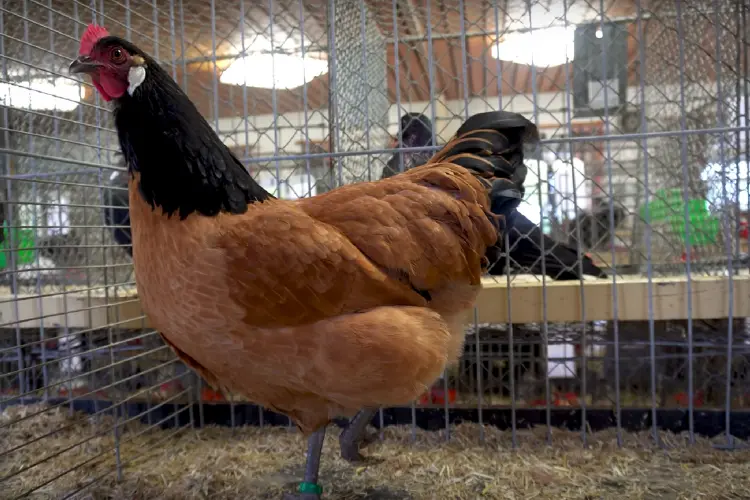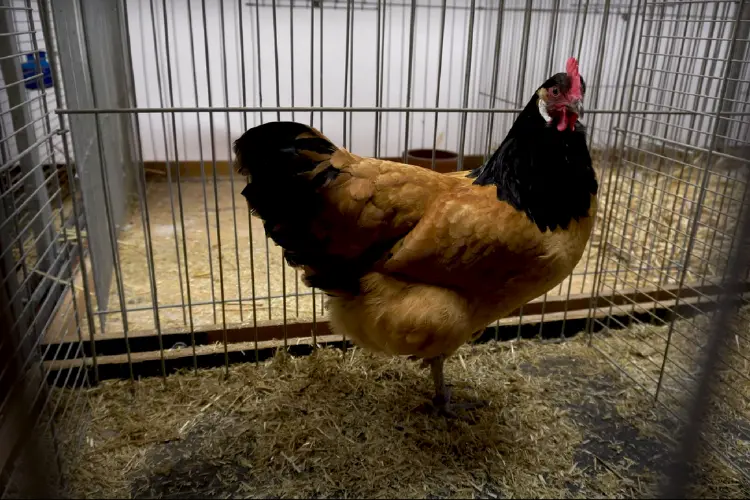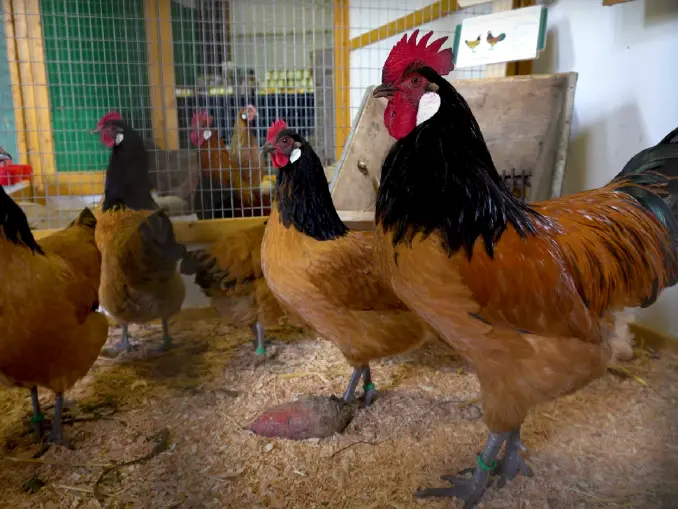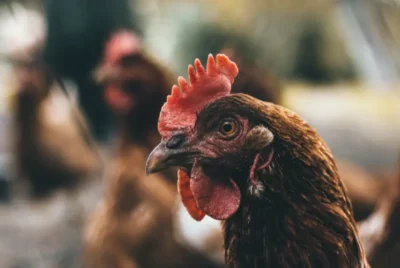Vorwerk Chicken Care Guide: Health, Diet, and More
Are you a poultry enthusiast searching for the ideal addition to your flock? Perhaps you’ve encountered the captivating allure of Vorwerk Chickens, with their striking golden plumage and versatile nature. While these chickens possess numerous admirable qualities, every breed comes with its own set of challenges and considerations.
So, in this guide, we’ll explore the pain points and essential factors to consider when raising Vorwerk Chickens, ensuring that you’re well-prepared for a rewarding poultry-keeping experience. Let’s delve into the unique challenges and rewards that come with these distinctive birds.
Vorwerk Chicken Quick Overview
- Origin: Germany
- Purpose: Raised for eggs, meat, and exhibition
- Egg Production: 170 eggs per year
- Plumage Color: Buff-colored body and black head, tail, and hackle
- Weight of Roosters: Approximately 7.05 pounds (3.2 kg)
- Weight of Hens: Approximately 5.5 pounds (2.5 kg)
- Personality: Active and alert, they are not shy and tend not to be aggressive
- Egg Color: Cream
- Egg Size: Medium
- Weight: Typically between 5 to 7 ounces (140 to 200 grams)
- Hardiness: Adaptable birds. Well-suited to cold climates
- Beginner-friendly: Yes

History of Vorwerk Chickens
The history of Vorwerk Chickens dates back to 1900 when Oskar Vorwerk, a poultry breeder, embarked on a mission to create a practical and medium-sized chicken breed with a distinctive plumage pattern reminiscent of the Golden Lakenvelder but featuring a dark golden base color.
By 1913, Oskar Vorwerk had successfully standardized this breed, subsequently named after him. Over time, both full-sized Vorwerk Chickens and Bantam variants were developed, with the American Bantam version created independently by Wilmar Vorwerk in 1966.
Despite its unique characteristics and utility, the breed remained relatively rare, with distinct standards in Europe and the United States.
Physical Appearance of the Vorwerk Chicken
Size
Vorwerk Chickens are classified as medium-sized birds, making them a practical choice for various poultry enthusiasts. While size can vary among individuals, there are general standards for Vorwerk Chicken size:
- Full-sized Vorwerk roosters typically weigh around 7.05 pounds (approximately 3.2 kilograms). These robust birds boast a sturdy build that reflects their utility on the farm.
- Vorwerk hens, on the other hand, reach an average weight of approximately 5.5 pounds (about 2.5 kilograms). Their slightly smaller size does not diminish their productivity.
Moreover, the Vorwerk Chicken breed also includes Bantam variants, which are smaller in size compared to their full-sized counterparts. These Bantam Vorwerks exhibit variations in weight standards, depending on whether they are in the United States or Europe.
Plumage Color
The plumage color of Vorwerk Chickens is perhaps one of their most striking and defining features. These chickens are renowned for their captivating and unique coloration:
- Roosters: Vorwerk roosters display deep buff bodies with a grey undercolor and white earlobes, creating a warm and earthy appearance. However, what truly sets them apart are their jet-black heads, tails, and hackles. This stark contrast between buff and black is a visual spectacle that draws attention.
- Hens: Hens of the Vorwerk breed share a similar color palette with buff areas or bodies. However, they may exhibit slight buff lace patterns at the back of their heads and in their tail feathers, adding a touch of elegance to their appearance.
- Non-Standard Variant: It’s worth mentioning that there is a non-standard slate blue plumage variant of the Vorwerk Chicken, providing an intriguing twist to the breed’s visual diversity.

Varieties
Vorwerk Chickens have a distinct place in the world of poultry, defined by European and British Poultry Standards. However, they are not listed in the Standard of Perfection of the American Poultry Association or the Australian Poultry Standard. This distinct classification underscores their unique nature.
Additionally, within the Vorwerk breed, there is a specific Bantam variety. The Vorwerk Bantam is recognized as a single variation in the list of recognized breeds by the American Bantam Association. This Bantam variant, like its full-sized counterparts, exhibits variations in weight standards, depending on whether it is in the United States or Europe.
Personality And Temperament of Vorwerk Chicken
The Vorwerk Chicken is characterized by a friendly and adaptable personality. These chickens are known for their gentle disposition, making them a delightful addition to poultry flocks. They exhibit alertness and activity, with a penchant for exploration and foraging.
While they are considered flighty, proper fencing can easily contain them. Vorwerk Chickens excel in both meat and egg production, and their hardiness extends to cold weather. They are also relatively calm and tolerant of each other, making them suitable for multi-rooster flocks.
Vorwerk Chicken Egg Production
Vorwerk Chickens are known for their impressive egg-laying capabilities, making them a valuable addition to poultry flocks. These birds typically produce around 170 eggs annually, with the eggs having an off-white or cream-colored shell.
One remarkable trait inherited from their Orpington ancestors is their ability to lay eggs consistently throughout the winter, ensuring a steady supply of eggs year-round. While a Vorwerk hen is not prone to broodiness, it can occasionally occur, necessitating an incubator for hatching eggs.
In addition to their egg-laying prowess, Vorwerk Bantam Chickens also contribute to egg production, although they produce smaller eggs, with an annual output of about 150-170 eggs

Vorwerk as Show Birds
Vorwerk Chickens have made a name for themselves in the world of bird shows, and their striking appearance is the key reason behind their popularity as show birds. Whether you’re showcasing hens or roosters, Vorwerks’ plumage and distinctive features make them exquisite birds for exhibition.
In the United States, it’s essential to note that only the Vorwerk Bantams have an established breed standard for exhibition purposes. However, it’s crucial to know that the U.S. breed standard for Vorwerk Bantams differs from the European standard.
Therefore, if you plan to exhibit your Bantam Vorwerks, meticulous attention to the specific standard in your region is paramount to ensure a successful show.
Caring for Vorwerk Chickens
Chicken Coop
The chicken coop serves as the primary shelter and living space for Vorwerk Chickens. You should offer them sufficient room to move around comfortably, typically at least 2-3 square feet per chicken.
Additionally, the coop must provide protection from adverse weather conditions, especially cold temperatures and rain. You must ensure proper insulation and ventilation to prevent drafts and maintain good air quality. Include nesting boxes and perches to facilitate egg laying and roosting. Regularly clean the coop to maintain cleanliness and hygiene within it, promoting the health of the chickens.
Feeding Requirements
Feeding Vorwerk Chickens involves providing them with a balanced diet that supports their nutritional needs. You should give them commercial poultry feed formulated for laying hens, ensuring they receive essential nutrients, vitamins, and minerals for optimal egg production.
While they can forage for insects, seeds, and greens in their environment, you need to provide supplemental feeding to meet their dietary requirements. Make sure they have access to clean and fresh water at all times for hydration and well-being.
Monitoring egg production helps ensure that the hens are receiving adequate nutrition and identifies any potential issues that require attention, such as changes in egg quality or quantity.

Breeding Vorwerk Chicken
Breeding Vorwerk Chickens involves overcoming their infrequent broodiness by utilizing incubators or having broodier hens available for nurturing eggs. These chickens mature relatively quickly after hatching, simplifying the breeding process.
For those aiming to breed show-quality Vorwerk Chickens, meticulous selection of breeding stock is essential. Adhering to breed standards, which require buff plumage without black spotting, can be a challenging task for breeders.
To increase the likelihood of success, it is advisable to wait until pullets reach their second year before selecting for breeding, allowing them to molt and aiding in the identification of pullets with undesirable black markings on their bodies.
Take Care of Your Chickens With Chicken Raising 101
The care of Vorwerk Chickens entails providing them with an environment that meets their needs and dietary requirements while considering their unique characteristics. These chickens, known for their prolific egg-laying abilities and active foraging nature, thrive in various settings, whether it’s a backyard coop or free-range system.
While they are not typically broody, their consistent egg production makes them valuable members of a flock. Showcasing their striking plumage at bird shows adds an extra dimension to their care.
Overall, the care guide for Vorwerk Chickens emphasizes the importance of proper housing, balanced nutrition, and attentive monitoring to ensure the health, happiness, and productivity of these remarkable birds in your care.
If you’re interested in learning more about chicken raising and gaining valuable insights into caring for various chicken breeds, we invite you to explore our website. Discover comprehensive guides, tips, and resources to help you become a successful and informed chicken raiser. Your journey into the world of poultry care starts here!




